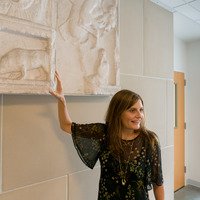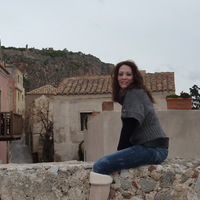
Peter Schultz
Peter Schultz is a conservationist, archaeologist, and entrepreneur. He's the former Olin J. Storvick Chair of Classical Studies at Concordia College, the current Executive Director of the Longspur Prairie Fund, and a Scholar in Residence in the Department of Visual Art at North Dakota State University. He received his BA summa cum laude in Art History, Philosophy, and Classics from Concordia College in 1994 and took his MA in Art History from Vanderbilt University in 1997. He received his PhD in Classical Archaeology from the University of Athens in 2003 with his dissertation Το εικονογραφικό πρόγραμμα του ναού της Αθηνάς Νίκης στην Ακρόπολη. Professor Schultz has held advanced fellowships from the National Endowment for the Humanities, the Fulbright Foundation, the A.G. Leventis Foundation, the Fritz-Thyssen Stiftung für Wissenschaftsförderung, the American School of Classical Studies, Athens -- and many others. He's the editor of Early Hellenistic Portraiture: Image, Style, Context (with Ralf von den Hoff; 2007 Cambridge University Press), Aspects of Ancient Greek Cult: Ritual, Context, Iconography (with Jesper Jensen, George Hinge and Bronwen Wickkiser; 2009 Århus University Press), Structure, Image, Ornament: Architectural Sculpture in the Greek World (with Ralf von den Hoff; 2009 Oxbow Press), Artists and Artistic Production in Ancient Greece (with Kristen Seaman; 2017 Cambridge University Press), Speaking the Past: Heritage, Discourse, and Publishing in the Digital Age (with Helle Hochscheid; Theran Press 2021), and the author of numerous articles on ancient Greek architecture, art, cult, and topography. Schultz's most recent academic books are The Thymele at Epidauros: Healing, Space, and Musical Performance in Late Classical Greece (co-authored with Bronwen Wickkiser, George Hinge, Chyrsanthos Kanellopoulos, and John Franklin; 2017 Theran Press) and Midwest Mediterranean. Finding Health & Flavor with the Foods of the North (co-authored with David Clardy, Megan Myrdal, Fadel Nammour, William Schultz and Noreen Thomas; Theran Press 2021), His research interests include the history of architecture, ancient Greek art and archaeology, archaeological theory, ecological theory, as well as modern Greek poetry, music, feasting, and landscape. He's currently working on a monograph that treat the sculptural program of the temple of Athena Nike in Athens with David Gill and Mike Lippman, a Greek counterpart to Peter Stewart’s A Social History of Roman Art for Cambridge University Press, a series of YA fantasy novels set in the Kingdom of Remain, and a number of freelance projects.
Academic interests: the history of architecture and art; ecological theory; information theory and cryptographic systems; archaeologies of mind, ritual, and cult; social and material culture; ancient Greek philosophy, history, and religion; the social history of art; architectural theory; the Classical tradition; and modern Greek music, feasting, poetry, and landscape.
Leadership interests: social entrepreneurship; publishing; ecological conservation; fund raising; crypto; global pedagogy; and the use of revolutionary philosophies and technologies for the advancement of the arts, the environment, and humanity.
O_o
Supervisors: Όλγα Παλαγγιά , Μανώλης Κορρές, Ισμήνη Τριάντη, Πέτρος Θέμελης , Βαλαβάνης Πάνος, Barbara Tsakirgis, and Vivien Green Fryd
Phone: ++1.701.866.8660
Academic interests: the history of architecture and art; ecological theory; information theory and cryptographic systems; archaeologies of mind, ritual, and cult; social and material culture; ancient Greek philosophy, history, and religion; the social history of art; architectural theory; the Classical tradition; and modern Greek music, feasting, poetry, and landscape.
Leadership interests: social entrepreneurship; publishing; ecological conservation; fund raising; crypto; global pedagogy; and the use of revolutionary philosophies and technologies for the advancement of the arts, the environment, and humanity.
O_o
Supervisors: Όλγα Παλαγγιά , Μανώλης Κορρές, Ισμήνη Τριάντη, Πέτρος Θέμελης , Βαλαβάνης Πάνος, Barbara Tsakirgis, and Vivien Green Fryd
Phone: ++1.701.866.8660
less
Related Authors
Catherine Keesling
Georgetown University
Verity Platt
Cornell University
Efi Oikonomou
Athens, National Archaeological Museum
Amalia Avramidou
Democritus University of Thrace
Ioannis Mylonopoulos
Columbia University
Joseph Day
Wabash College
Claudia Wagner
University of Oxford
Andrew Stewart
University of California, Berkeley
Adele Scafuro
Brown University
InterestsView All (62)









Uploads
Books by Peter Schultz
It’s a book for people who share a zeal for healthy food, healthy minds, and healthy hearts.
It’s a book for people who love cooking, love living, and love feeling their very best.
It’s a book for people who want to feed their bodies and their souls.
While this book does contain some incredible recipes curated from some of the most exciting chefs of the High Plains, it’s not just a “cookbook.” (Or a “health book.” Or a “diet book,” for that matter.) Rather, this book is an amazing smorgasbord of principles and particulars - a kind of eclectic community table, a table at which we can all sit, share, learn, and enjoy. In this case, the table is loaded with some truly life-changing ideas that will transform the way you eat and live.
In this important book, an international, interdisciplinary team has compiled, synthesized, and speculated on a host of new (and old) clues that bring the puzzles circling the thymele at Epidauros into clearer focus. While the ancient ideas and intentions that motivated the construction of this remarkable building remain shrouded by time, the material evidence, the epigraphical record, and the literary testimonia hold numerous potential solutions. Through reexamination of these clues and their contexts, the authors hope to spark fresh debate regarding the form, the function, and the meaning of this unique and mysterious ancient structure.
https://www.amazon.com/Bear-His-Daughter-Tale-Canon-ebook/dp/B07B3WVRVQ
https://www.amazon.co.uk/Bear-His-Daughter-Tale-Canon-ebook/dp/B07B3WVRVQ/
https://www.amazon.com/Blind-Dragon-Tale-Canon-Tarn/dp/1944296026
https://www.amazon.co.uk/Blind-Dragon-Tale-Canon-Tarn/dp/1944296026
Papers by Peter Schultz
problem recently discovered in the Parthenon buildingaccount
inscriptions. As restored, the accounts (IG 13 449,
lines 389–94) specify the purchase and sale of a large lot
of ivory quite late in the building’s construction. Where
was this ivory used? Since the ivory cannot readily be connected
to Pheidias’ chryselephantine image of Athena,
this material can be associated with the decoration of
the Parthenon’s enormous cedar doors. In addition to
a range of epigraphical and structural evidence supporting
this hypothesis, the literary and archaeological data
suggest a long tradition of adorning doors with gold and
ivory in Greek sacred architecture. The Parthenon was a
fundamental part of this tradition. Indeed, by creating a
gold and ivory frame to complement and emphasize Pheidias’
gleaming statue, the Parthenon’s designers played
on ancient expectations regarding divine images and
enhanced the epiphanic effect of Pheidias’ masterpiece
and the Parthenon as a whole.
It’s a book for people who share a zeal for healthy food, healthy minds, and healthy hearts.
It’s a book for people who love cooking, love living, and love feeling their very best.
It’s a book for people who want to feed their bodies and their souls.
While this book does contain some incredible recipes curated from some of the most exciting chefs of the High Plains, it’s not just a “cookbook.” (Or a “health book.” Or a “diet book,” for that matter.) Rather, this book is an amazing smorgasbord of principles and particulars - a kind of eclectic community table, a table at which we can all sit, share, learn, and enjoy. In this case, the table is loaded with some truly life-changing ideas that will transform the way you eat and live.
In this important book, an international, interdisciplinary team has compiled, synthesized, and speculated on a host of new (and old) clues that bring the puzzles circling the thymele at Epidauros into clearer focus. While the ancient ideas and intentions that motivated the construction of this remarkable building remain shrouded by time, the material evidence, the epigraphical record, and the literary testimonia hold numerous potential solutions. Through reexamination of these clues and their contexts, the authors hope to spark fresh debate regarding the form, the function, and the meaning of this unique and mysterious ancient structure.
https://www.amazon.com/Bear-His-Daughter-Tale-Canon-ebook/dp/B07B3WVRVQ
https://www.amazon.co.uk/Bear-His-Daughter-Tale-Canon-ebook/dp/B07B3WVRVQ/
https://www.amazon.com/Blind-Dragon-Tale-Canon-Tarn/dp/1944296026
https://www.amazon.co.uk/Blind-Dragon-Tale-Canon-Tarn/dp/1944296026
problem recently discovered in the Parthenon buildingaccount
inscriptions. As restored, the accounts (IG 13 449,
lines 389–94) specify the purchase and sale of a large lot
of ivory quite late in the building’s construction. Where
was this ivory used? Since the ivory cannot readily be connected
to Pheidias’ chryselephantine image of Athena,
this material can be associated with the decoration of
the Parthenon’s enormous cedar doors. In addition to
a range of epigraphical and structural evidence supporting
this hypothesis, the literary and archaeological data
suggest a long tradition of adorning doors with gold and
ivory in Greek sacred architecture. The Parthenon was a
fundamental part of this tradition. Indeed, by creating a
gold and ivory frame to complement and emphasize Pheidias’
gleaming statue, the Parthenon’s designers played
on ancient expectations regarding divine images and
enhanced the epiphanic effect of Pheidias’ masterpiece
and the Parthenon as a whole.
blocks XI–XII in particular, indicates that the leading apobates
contestant is the winner in this Panathenaic contest.
Evidence from James Stuart’s 1751–1753 drawing and his
brief commentary support a reading of the so-called marshal
beyond the horses as the judge bestowing the victor’s
wreath, and comparanda for this figure can be found in
other art forms. The emphasis of this scene then shifts
from the race to the victory and reinforces the presence
of nike in the iconographic program of the Parthenon.
Because of his distinctive costume, this apobates contestant
may be identified as belonging to the foremost Athenian
tribe, Erechtheis.